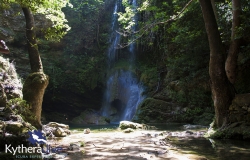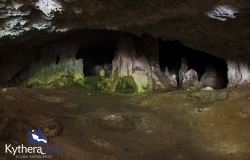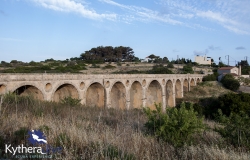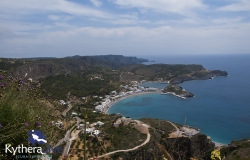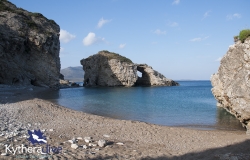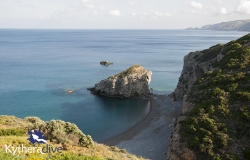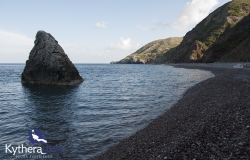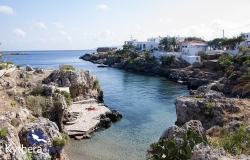THE ISLAND OF KYTHIRA
The Myth
The island where Aphrodite was born,
According to Hesiod's "Theogony," when Cronus cut off the genitalia of Uranus, he threw them into the sea on the island of Kythira. Aphrodite, the goddess of love, was born from the foam. The birth of the beautiful Cytherean goddess has a common symbolic reference to the emergence of the island from the sea, which is evidenced by marine findings from the Paleolithic period found on the island.
The Reality
An island of 280 square kilometers and 4000 inhabitants with a mild Mediterranean climate that hardly ever snows. It produces excellent olive oil and honey. It is connected by air throughout the year daily to Athens, periodically to European countries, and by sea all year round to Piraeus, Kastelli in Crete, and periodically to Neapolis, Gytheio, and Kalamata.
The visitor encounters vegetation everywhere, waterfalls, watermills, old stone houses, settlements from another era, Byzantine, Venetian, and English castles and monuments, and many impressive caves. A plethora of underwater caves, mainly on the southwestern side of the island, remain unexplored. The visitor must definitely see Chora with its impressive castle and alleys untouched by time, Mylopotamos (perhaps the most beautiful village of Kythira) with the Fonissa waterfall, the castle, and the watermills, and have a coffee under the plane tree in the square, Avlemonas, a beautiful harbor with the Venetian castle, Palaiopolis, the Byzantine capital of the island fortified in a spectacular gorge, Aroniadika that takes you back in time, the bridge at Katouni (nowhere else in Greece will you see such a large stone bridge), Kapsali picturesque and modern at the same time, the cave of Ag. Sophia in Mylopotamos, the rocky islet of Hytra with the beautiful cave, the verdant Mitata, and the village with the springs, Karava. As for the churches, the lines in this electronic text are not enough, nor can we even list the most important ones. Among the most unique beaches are Kaladi, Melidoni, Firi Ammos, Kalami, Chalkos, Platia Ammos, Limnionas, Ag. Pelagia, Diakofti, Komponada.
After all, the visitor of Kythira is above all a explorer. They are characterized by a strong desire for discovery, they are poets, walkers, nature lovers, and usually seek a starry sky, gurgling waters from waterfalls, secluded beaches, legends, and traditions to live their own dream...
Voyage à Cythère.
SightSeeings
Castle of Chora
The most characteristic monument of the island is the castle of Chora! The castle or "Fortezza" was built around the 13th century when the Venetians dominated Kythira. The "Eye of Crete," as it was called because of its strategic position, overseeing the movement of ships in three seas simultaneously, the Ionian, Aegean, and Cretan, was built at various stages of the island's history, but the largest and most important part with the façade was built in 1503 by the Venetians, who repaired and rebuilt it.
More...Moudari Lighthouse
It is the lighthouse located at the northernmost point of the island, at Cape Spathe. Built during the British rule, it is the largest built by the British in the Greek area. It's worth a visit after securing a guide and information from the village of Karavas. Enjoy the view after climbing up the lighthouse. Amazing panorama.
More...Hytra
One of the most impressive places on the island is the islet of Hytra or Egg, which is located a short distance from the port of Kapsali. It has a sea cave on its south side with colors that enchant you both outside and inside the sea. At the end of this cave, there is a shelter for seals...
More...Tsakonas Gorge
The Tsakonas Gorge is located between two villages, Mitata and Viaradika, in the center of the island. Inside the gorge, there are carved hidden churches in the rocks as well as two springs, one for each village. After several kilometers and several branches, the gorge ends in the area of Paleopolis.
More...Watermills
Descending the valley of Milopotamos around and below the waterfall of "Fonissa" on the rocks, between their plane trees and ivy, 22 watermills are built. The watermills operated with the power of the river water, which still flows abundantly today.
More...Kakia Lagada Gorge
The Kakia Lagada Gorge starts from the village of Trifyllianika and passes next to the ruined Byzantine Fortress of Paleochora. Paleochora, with its buildings from the 13th century, was the Byzantine capital of the island and is located in the northern part of a steep rock, which appears in the middle of the gorge...
More...Elgin Shipwreck
A little outside the harbor of Avlemonas, an ancient shipwreck was discovered by a group of archaeologists from the Institute of Marine Archaeological Research in 1980, at a depth of about 20 meters! It was the ship "Mentor" of Lord Elgin, which in 1802 transported the stolen sculptures of the Parthenon and fragments of other monuments...
More...Waterfall of Fonissa
In the picturesque village of Milopotamos, you will find a sign "Naiad, Waterfall" that leads you to an idyllic place with tropical greenery and beautiful bridges. A magical place full of pathways and streams, within a ravine, characterized by natural beauty, rich in vegetation with planes and sycamores..
More...

